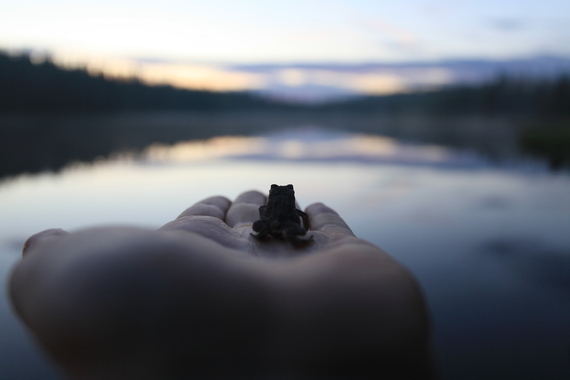We're beaming through the darkness. My friend turns off the motorboat engine and we glide in silence on the mild rocking waves of the Baltic Sea. The chilly October evening numbs my fingertips. We turn off the LED lights and accustom our eyesight to find the buoy marking the fishing nets. I close my eyes and listen to the low humming of Helsinki in the background. The city lights are glimmering over the calm sea just one nautical mile away. We're floating in our urban backyard.
The catch is exciting: delicious perch bass, a couple of lonely Baltic herrings, roach to be donated to the seagulls and two delicious pike-perch to be oven-baked. As our boat flies under the stars towards the harbor, I'm experiencing an overwhelming feeling of gratitude and connection with nature. We're part of it.
I believe my fellow Scandinavians can share my feelings: We, the lucky ones, grew up close to nature, taking a lot for granted: our tap water is the cleanest in the world and we are able to bike or walk to our free universities and healthcare clinics. We have been instilled with a strong sense of responsibility to nature. We pick berries in the forests and meticulously sort our trash for recycling. In the most polluted cities in India, Pakistan or China, the concentration of harmful fine particles in the air can be 100-200 times higher than in any Nordic capital. It's good to breath in the air at the top of the world.
Enter survival mode
We are living in the times of rapidly increasing scarcity. The coming lack of resources will dictate new methods of production and consumption. Smart living, mobility and energy will become the default for all of us.
This suits us Nordics. We settle for less and our functional designs are made to fit the context. We are accustomed to moderate consumption. The size of an American "small-sized" Coke is a shared joke among us.
Like the rest of the western world, the Nordics still consume more than our fair share of resources. Our extreme climate and long distances have pushed us to warm up our homes more efficiently and we improve all the time; renewable energy sources account for a third of total energy consumption in the Nordics. According to the IEA, the Nordic countries are 25 years ahead of the rest of the world in terms of reducing the carbon impact of electricity production.
The green direction is clear. Nordic cities and societies are developing into smart hyperconnected communities, where symbiotic mindsets and social applications will further refine the exchanges of waste, water and materials in energy-efficient ways.
An organic movement
The Nordic countries are currently abundant with initiatives, projects and innovations supporting energy-efficiency in buildings, transportation, industrial processes, products and services. The new startup generation is pitching in Nordic events and competitions such as Slush, Peloton, Swedish Venture Cup and Nordic Build Cities to name a few. There is a long list of exciting startups. Malmö-based Orbital Systems is redesigning water consumption. Icelandic Valorka harvests tidal powers. Finland's Mad Cook is an emerging startup introducing bugs as the answer to tour unsustainable meat consumption. Paptic is finally providing a much needed fiber replacement for plastic bags and Enevo shows that even trash cans can be smart.
Green Profits
Inspired by visionary Uruguay, and Vancouver showing an example of profitable green transformation, Denmark has launched the "State of Green," a vision to create economic profit alongside ending fossil fuel consumption by 2050. The connection between economic growth and the move towards a carbon-free society is widely accepted as an opportunity.
Although small individually, the importance of the Nordic countries as a group is considerable. All Nordic countries are ranked in the top 20 economies of the world. The combined gross domestic product of the Nordic Region makes it the world's twelfth largest economy with a total GDP of 1700 billion US dollars in 2014.
Scandinavia is currently in the middle of a systemic rise of the green, bottom-up economy creating new business opportunities. We have a swarm of Nordic solutions, yet we're missing The Nordic Solution for the World.
Nordic Joint Venture - The Green Lab for Mother Earth
Nordic progress is currently happening in the silos in the speed of evolution. We share the green mindset, yet we are missing the opportunity to become a winning team to create the much-needed revolution.
Nordic countries should set a joint ambition and agree on a long-term shared plan. We need a bold Nordic vision to save the planet. This joint quest should have an inspiring economic driver providing long-haul opportunities to partners hailing from the lean bottom-up movement and the public sector. There's a huge upside in saving the world together.
For now, we're lonely fisherman in the dark sea. We must have strong nets to catch the big fish. We need to connect the green dots.
Image: Leap of Faith, Risto Kuulasmaa
This post is part of a "Nordic Solutions" series produced by The Huffington Post, in conjunction with the U.N.'s 21st Conference of the Parties (COP21) in Paris (Nov. 30-Dec. 11), aka the climate-change conference. The series will put a spotlight on climate solutions from the five Nordic countries, and is part of our What's Working editorial initiative. To view the entire series, visit here.
